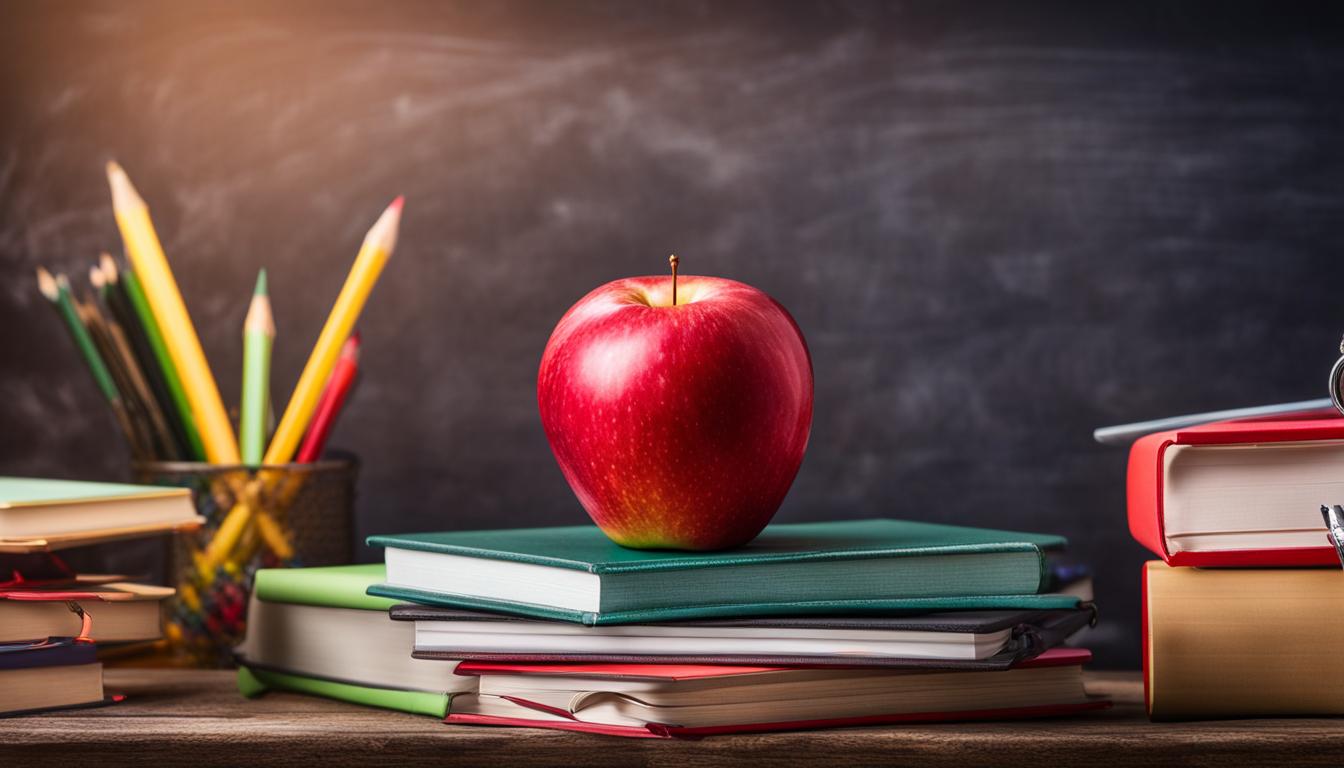Comprehensive Back-to-School Handbook for Parents and Teachers
Welcome to our Comprehensive Back-to-School Handbook for Parents and Teachers! As we approach the start of a new school year, we understand the importance of equipping parents and teachers with the tools and strategies to ensure a successful academic journey for students. This comprehensive handbook is designed to provide valuable back-to-school tips, promote student success, and foster effective parent-teacher collaboration.
At [Company Name], we believe that when parents and teachers work together, students thrive. By utilizing the guidance and resources in this handbook, parents and teachers can create a positive and productive learning environment that supports every child's growth and development.
Key Takeaways:
- Our Comprehensive Back-to-School Handbook equips parents and teachers with valuable tips and strategies for a successful school year.
- Promoting student success is a key focus in the handbook, emphasizing the importance of academic goals and extracurricular activities.
- Effective communication and collaboration between parents and teachers are crucial for creating a supportive learning environment.
- The handbook provides practical advice for teachers on classroom management techniques and behavior management.
- By utilizing the resources in the handbook, parents can ensure their child is ready for the school year with a comprehensive school preparation checklist.
Stay tuned as we delve into the importance of parent collaboration and involvement in Section 2 of our Comprehensive Back-to-School Handbook for Parents and Teachers.
Importance of Parent Collaboration and Involvement
Parent collaboration and involvement are key factors in creating a successful classroom. When parents actively participate in their child's education, it fosters a positive and supportive learning environment. By starting the school year with a comprehensive handbook for each family, parents are empowered with the necessary information to be active participants in their child's education.
This handbook serves as a valuable tool to facilitate open communication and support between parents and teachers. It provides important insights into classroom policies, contact details, homework expectations, and the class schedule. With this information at their fingertips, parents can stay informed and involved throughout the school year, ultimately contributing to their child's success.
Effective parent collaboration and involvement have numerous benefits for both students and teachers. When parents play an active role in their child's education, students are more motivated and exhibit stronger social skills. Additionally, teachers can gain valuable insights and support from parents, enabling them to tailor their teaching strategies to meet the needs of each student. By fostering a collaborative relationship between parents and teachers, we can create a successful learning community that promotes student achievement and growth.
| Benefits of Parent Collaboration and Involvement | Benefits for Students | Benefits for Teachers |
|---|---|---|
| Improved academic performance | Enhanced motivation | Insights and support from parents |
| Stronger social skills | Greater engagement | Individualized teaching strategies |
| Increased attendance | Positive mindset | Better classroom management |
Parent collaboration and involvement are essential for creating a successful classroom. By providing parents with the necessary tools and resources, such as a comprehensive handbook, we can foster open communication and support between parents and teachers. Together, we can create a positive and engaging learning environment that promotes student success and achievement.
Utilizing a Classroom Handbook
The classroom handbook is an essential tool for both parents and teachers to ensure a successful school year. It is typically distributed during Open House or Back to School Night, providing parents with important information at their fingertips. This handbook serves as a valuable resource, allowing parents to stay informed and involved throughout the school year.
One of the key benefits of using a classroom handbook is its customizability. Each handbook can be assembled with editable titles and text, making it adaptable to the specific needs and requirements of each classroom. This ensures that important information such as classroom policies, contact details, homework expectations, and the class schedule are easily accessible to parents.
By providing parents with a comprehensive guide to the classroom, the handbook promotes open communication and collaboration between parents and teachers. It sets the foundation for a strong partnership, enhancing the overall learning experience for students. Whether it's clarifying expectations, addressing concerns, or celebrating achievements, the handbook facilitates effective parent-teacher communication throughout the school year.
Furthermore, the classroom handbook serves as a reference point for parents, allowing them to navigate the school year confidently. It provides a sense of assurance and support, enabling parents to actively engage in their child's education. This involvement is crucial for promoting student success and creating a positive learning environment.
The Benefits of Utilizing a Classroom Handbook:
- Promotes open communication between parents and teachers
- Provides a comprehensive guide to the classroom
- Fosters strong parent-teacher collaboration
- Enhances parent involvement in their child's education
- Creates a positive learning environment for students
By utilizing a classroom handbook, parents and teachers can work together to ensure the success and well-being of students throughout the school year.
Content of the Handbook
In this section, we will delve into the content of the Comprehensive Back-to-School Handbook for Parents and Teachers. This editable handbook is a valuable tool that provides all the necessary information for a successful school year. Whether you're a teacher or a parent, this handbook serves as a comprehensive guide to create a positive learning environment.
Sample Version and How-To Guide
The handbook includes a sample version that serves as a reference for customization. It showcases different sections such as classroom policies, contact details, homework expectations, and class schedules. This sample version provides a clear understanding of how the handbook can be personalized to meet the unique needs of each classroom.
Additionally, the handbook offers a step-by-step guide on how to assemble the editable version. This guide ensures that both parents and teachers can navigate through the process easily, making it user-friendly and accessible to all. With the help of this how-to guide, creating a tailored handbook becomes a seamless experience.
Complete Handbook Table
| Section | Description |
|---|---|
| Classroom Policies | Outlines rules, expectations, and procedures to ensure a structured learning environment. |
| Contact Details | Provides relevant contact information for parents to communicate with the teacher. |
| Homework Expectations | Explains guidelines and expectations regarding homework assignments. |
| Class Schedule | Offers a clear overview of the daily and weekly class schedule. |
The Comprehensive Back-to-School Handbook for Parents and Teachers ensures that all pertinent information is easily accessible. With an editable format, a sample version for reference, and a helpful how-to guide, this handbook streamlines the process of creating a customized resource for each classroom. Parents and teachers can work hand in hand to foster a positive and productive learning environment for every student.
Parent Involvement Resources
In addition to the classroom handbook, we provide a range of resources to support parent involvement and engagement. These resources are designed to help parents navigate the back-to-school process effectively and stay connected with their child's education throughout the school year.
- Back to School guides: Our comprehensive Back to School guides offer practical tips, advice, and checklists to help parents prepare their children for the new academic year. These guides cover various topics such as school supplies, school routines, and supporting academic success.
- Open House materials: We provide Open House materials that include templates for welcome letters, parent sign-up sheets, and classroom expectations. These materials are designed to facilitate communication between parents and teachers and create a welcoming environment for families.
- Meet the Teacher Night resources: Our Meet the Teacher Night resources help parents make the most of this important event. We provide sample agendas, tips for effective communication, and suggestions for questions to ask the teacher. These resources aim to foster positive parent-teacher relationships and ensure parents feel informed and engaged.
“Parent involvement is a key factor in student success. By providing parents with resources and guidance, we empower them to actively participate in their child's education and create a supportive learning environment.”
These resources are designed to be easily accessible and user-friendly. They are available in both print and digital formats, allowing parents to choose the option that works best for them. By offering these additional resources alongside the classroom handbook, we aim to foster strong parent-teacher partnerships and support student success.
Table: Comparison of Back-to-School Resources
| Resource | Features | Benefits |
|---|---|---|
| Back to School guides | – Practical tips and checklists – Covers various back-to-school topics – Printable and digital formats available |
– Helps parents prepare their children – Ensures a smooth transition – Promotes organization and readiness |
| Open House materials | – Templates for welcome letters and sign-up sheets – Classroom expectations and information – Customizable for each classroom |
– Facilitates communication and collaboration – Sets clear expectations – Creates a welcoming environment |
| Meet the Teacher Night resources | – Sample agendas and communication tips – Questions to ask the teacher – Guidance on building relationships |
– Establishes positive parent-teacher connections – Provides important information – Offers guidance for parent involvement |
The Benefits of Parent Involvement in Education
Parent involvement in education is a key factor in promoting student success and enhancing academic performance. When parents actively participate in their child's education and collaborate with teachers, it creates a powerful partnership that positively impacts the learning journey. Numerous studies have shown the benefits of parent involvement, ranging from increased motivation and stronger social skills to improved grades and overall academic achievement.
In a study conducted by the National Education Association, it was found that students with highly involved parents are more likely to have higher grades, attend school regularly, and have better social skills. Additionally, students whose parents are actively engaged in their education have a higher likelihood of graduating and pursuing higher education opportunities. This strong correlation between parent involvement and student success highlights the significance of fostering a supportive home-school partnership.
By actively participating in their child's education, parents can provide valuable support both inside and outside the classroom. They can reinforce learning at home, help with homework, communicate with teachers, and advocate for their child's needs. This collaborative approach ensures that students receive consistent support and encouragement, leading to increased confidence, motivation, and achievement.
Effective parent involvement strategies include attending parent-teacher conferences, volunteering at school events, participating in school decision-making processes, and staying informed about their child's progress. Open lines of communication between parents and teachers facilitate regular updates on academic performance, behavior, and any concerns or challenges that may arise. This partnership between parents and teachers creates a holistic support system that fosters student success.
Benefits of Parent Involvement in Education:
- Increased motivation and engagement
- Stronger social skills and relationships
- Improved grades and academic performance
- Higher likelihood of graduating and pursuing higher education
- Enhanced confidence and self-esteem
- Consistent support and reinforcement of learning
- Opportunities for parents to be advocates for their child's needs
- Improved communication and collaboration between home and school
Parent involvement is a crucial component of creating a positive and nurturing educational environment. When parents and teachers work together, students can thrive academically, socially, and emotionally, setting them up for lifelong success.
| Strategies for Parent Involvement | Benefits for Students |
|---|---|
| Attending parent-teacher conferences | Increased communication and understanding of student progress |
| Volunteering at school events | Positive role modeling and increased engagement in school community |
| Participating in school decision-making processes | Opportunity to contribute ideas and perspectives for school improvement |
| Staying informed about child's progress and school activities | Support and reinforcement of learning at home |
| Advocating for child's needs | Ensuring individualized support for academic, social, and emotional growth |
Effective Teaching Strategies for Student Success
In order to promote student success and create a positive learning environment, teachers must utilize effective teaching strategies. These strategies not only enhance student engagement but also foster critical thinking and academic growth. By implementing a variety of techniques, educators can accommodate different learning styles and help students reach their full potential.
Instructional Differentiation
One of the key strategies for effective teaching is instructional differentiation. This approach recognizes that students learn and process information differently, and therefore, instruction should be tailored to meet individual needs. By differentiating instruction, teachers can provide appropriate support, challenge, and engagement for every student in the classroom. This can be achieved through the use of various instructional methods, such as small group work, individualized assignments, and flexible seating arrangements.
Active Learning
Another important teaching strategy is active learning, which involves engaging students directly in the learning process. Instead of passively listening or observing, students actively participate in discussions, experiments, projects, and other hands-on activities. This not only promotes a deeper understanding of the subject matter but also enhances critical thinking, problem-solving, and collaboration skills. By incorporating active learning techniques, such as group work, debates, and role-playing, teachers can create a dynamic and interactive classroom environment.
Effective Classroom Management
A well-managed classroom is essential for student success. Effective classroom management involves creating clear expectations, establishing routines, and maintaining a positive learning atmosphere. By setting behavioral guidelines and consistently reinforcing them, teachers can create a safe and respectful environment where students feel supported and motivated to learn. Additionally, utilizing proactive strategies, such as positive reinforcement and rewards, can help prevent disruptive behavior and promote a positive classroom culture.
| Effective Teaching Strategies | Benefits for Student Success |
|---|---|
| Instructional Differentiation | Accommodates diverse learning styles Meets individual student needs Promotes academic growth |
| Active Learning | Enhances critical thinking skills Fosters collaboration and problem-solving abilities Deepens understanding of subject matter |
| Effective Classroom Management | Creates a positive and respectful learning environment Encourages student engagement and motivation Prevents disruptive behavior |
By implementing these effective teaching strategies, educators can enhance student success and create a classroom environment that fosters academic growth, critical thinking, and positive behavior. These strategies empower students to take ownership of their learning and engage actively in the educational process. Moreover, by utilizing instructional differentiation, active learning, and effective classroom management techniques, teachers can support the diverse needs of their students and promote a love for learning.
School Preparation Checklist
Preparing for the new school year can be an overwhelming task for parents and students alike. To ensure a smooth transition, we have created a comprehensive school preparation checklist to help you stay organized and ready for the upcoming academic year. This checklist covers everything from essential school supplies to important health requirements. By following this guide, you can start the school year with confidence.
Back-to-School Tips
- Gather a list of required school supplies and purchase them in advance.
- Check the school's dress code policy and ensure your child has appropriate attire.
- Review the school's transportation arrangements and plan accordingly.
- Make sure your child's immunizations are up to date and schedule any necessary appointments.
- Label all personal belongings with your child's name to prevent loss.
- Establish a consistent sleep schedule to ensure your child is well-rested for school.
- Discuss any anxieties or concerns with your child and reassure them about the new school year.
School Supplies Guide
Having the right school supplies can greatly contribute to your child's success in the classroom. Below is a table outlining the essential school supplies your child may need:
| Item | Quantity |
|---|---|
| Backpack | 1 |
| Writing utensils (pens, pencils, markers) | Multiple |
| Notebooks | 3-5 |
| Binders | 2-3 |
| Folders | 5-7 |
| Ruler | 1 |
| Scissors | 1 |
| Glue sticks | 2-3 |
| Calculator | 1 |
Remember, this is just a general guide and may vary depending on your child's grade level and specific classroom requirements. It's always a good idea to check with your child's teacher or school for any additional supplies recommended.
With this school preparation checklist and the right school supplies, you can ensure that your child is ready to tackle the new academic year. By starting off on the right foot, you are setting the stage for a successful and productive school year.
Promoting Student Success
Promoting student success goes beyond academic achievement. It is about nurturing the holistic development of each student, helping them set and achieve their goals, and encouraging their engagement in extracurricular activities. At our school, we believe that a well-rounded education includes not only strong academic skills but also the cultivation of personal qualities and interests that contribute to a student's overall growth.
By providing opportunities for students to explore their passions outside of the classroom, we aim to foster their individual talents and strengths. Our extracurricular activities range from sports teams and clubs to art, music, and theater programs. These activities not only enhance students' skills and knowledge in specific areas but also instill important values such as teamwork, discipline, and perseverance.
“Extracurricular activities provide a platform for students to develop leadership skills, build self-confidence, and discover their unique strengths and abilities.” – Dr. Jane Thompson, Principal
Benefits of Promoting Student Success
Engagement in extracurricular activities has been shown to have numerous benefits for students. It helps them develop time management skills, learn how to balance academic and non-academic commitments, and build a sense of responsibility. Participating in these activities also strengthens their social connections, allows for meaningful interactions with peers and mentors, and fosters a sense of belonging within the school community.
Furthermore, involvement in extracurricular activities has been linked to improved academic performance. By engaging in a diverse range of activities, students develop transferable skills such as critical thinking, problem-solving, and communication that can positively impact their overall academic success. These experiences also provide students with opportunities to explore potential career paths and develop a sense of direction for their future.
At our school, we encourage all students to actively participate in extracurricular activities. Whether it's joining a sports team, participating in the school band, or taking part in community service projects, we believe that these experiences contribute significantly to the well-rounded development and future success of our students.
| Benefits of Promoting Student Success | Extracurricular Activities |
|---|---|
| Enhances personal growth and self-discovery | Sports teams |
| Develops leadership and teamwork skills | Clubs and organizations |
| Cultivates time management and organizational skills | Art, music, and theater programs |
| Fosters social connections and a sense of belonging | Community service projects |
| Improves academic performance | Academic teams and competitions |
By nurturing student success both inside and outside of the classroom, we strive to create a supportive and enriching educational environment. Through a combination of academic excellence, extracurricular engagement, and a focus on individual growth, we aim to prepare our students for future success in all areas of their lives.
Classroom Management Techniques
In order to create a positive and productive learning environment, effective classroom management techniques are crucial. These techniques help teachers establish clear expectations, maintain discipline, and foster a supportive atmosphere for students. By implementing behavior management strategies and utilizing positive reinforcement, teachers can promote a harmonious classroom that facilitates student engagement and academic success.
Behavior Management Strategies
One key aspect of classroom management is implementing behavior management strategies. These strategies involve setting clear rules and expectations for student behavior and addressing any disruptive or challenging behaviors effectively. It is important for teachers to establish consistent consequences for misbehavior while also providing opportunities for students to learn from their mistakes. By utilizing techniques such as verbal reminders, redirection, and individual behavior plans, teachers can address behavioral issues proactively and maintain a focused learning environment.
Positive Reinforcement
Positive reinforcement is another essential technique in classroom management. By acknowledging and rewarding desired behaviors, teachers can create a positive and motivating atmosphere for students. This can be done through verbal praise, encouragement, and small rewards such as stickers or certificates. Positive reinforcement not only reinforces good behavior but also helps build students' self-esteem and self-confidence. By focusing on positive reinforcement rather than punishment, teachers can encourage students to actively participate and engage in the learning process.
Classroom Management Techniques
Effective classroom management techniques encompass a range of strategies that promote student engagement and cooperation. These techniques may include implementing a structured daily routine, providing clear instructions, and organizing the classroom environment to facilitate learning. Teachers may also utilize group work, cooperative learning activities, and interactive teaching methods to enhance student involvement. By employing these techniques, teachers can create a classroom that fosters collaboration, critical thinking, and active participation.
Table: Classroom Management Techniques Comparison
| Technique | Description | Benefits |
|---|---|---|
| Behavior Management Strategies | Involves setting clear rules and expectations, addressing disruptive behavior, and providing consistent consequences. | Establishes discipline, maintains a focused learning environment, and teaches students responsibility. |
| Positive Reinforcement | Involves acknowledging and rewarding desired behaviors, providing verbal praise, encouragement, and small rewards. | Motivates students, builds self-esteem, and reinforces positive behavior. |
| Structured Daily Routine | Involves establishing a consistent schedule and sequence of activities to provide structure and predictability for students. | Promotes organization, time management, and reduces disruptions. |
| Group Work and Cooperative Learning | Involves collaborative projects, discussions, and activities where students work together to achieve common goals. | Fosters teamwork, communication skills, and active engagement. |
| Interactive Teaching Methods | Involves using hands-on, experiential, and technology-based approaches to make learning more interactive and engaging. | Enhances student involvement, critical thinking, and retention of knowledge. |
By utilizing effective classroom management techniques such as behavior management strategies and positive reinforcement, teachers can create an environment that promotes student success. These techniques establish clear expectations, address disruptive behavior, and foster a positive and engaging atmosphere for learning. By implementing a structured routine, encouraging cooperative learning, and utilizing interactive teaching methods, teachers can help students develop essential skills and reach their full potential.
Parent Communication and Engagement
Effective parent communication and engagement are essential components of a successful school-home partnership. When parents and teachers work together, it creates a supportive and nurturing environment that benefits students academically, socially, and emotionally. By fostering open lines of communication and involving parents in school activities, we can ensure that every child receives the necessary support and resources to thrive.
One of the key aspects of parent communication is establishing regular channels for updates and information sharing. This can include newsletters, emails, or a dedicated parent portal on the school's website. By providing timely and relevant updates about classroom activities, assignments, and upcoming events, we keep parents informed and involved in their child's education.
In addition to regular updates, it is important to create opportunities for face-to-face interaction between parents and teachers. Parent-teacher conferences, open houses, and back-to-school nights are valuable occasions for parents to meet with teachers, ask questions, and gain a deeper understanding of their child's progress. These events also allow teachers to gain valuable insights from parents about their child's strengths, challenges, and individual needs.
Furthermore, involving parents in school activities can foster a sense of belonging and community. Parent volunteers can contribute in various ways, such as assisting in the classroom, organizing fundraisers, or participating in school events. Their active engagement not only benefits the school but also demonstrates to students the importance of community involvement and collaboration.
In conclusion, strong parent communication and engagement form the foundation of a successful school-home partnership. By fostering open lines of communication, involving parents in school activities, and creating opportunities for face-to-face interactions, we can build a supportive and collaborative environment that allows students to thrive. Together, parents and teachers play a critical role in shaping the educational journey of each child, ensuring their success in both academic and personal growth.
Conclusion
In conclusion, the Comprehensive Back-to-School Handbook for Parents and Teachers is a valuable resource that aims to ensure school year success through effective parent-teacher collaboration. By promoting parent collaboration and involvement, we can create a positive and productive learning environment for all students.
This handbook serves as a guide, providing essential information and helpful tips to empower parents and teachers. With the support of parents and teachers working together, students can thrive academically and personally.
Whether it's preparing for the school year, promoting student success, or fostering strong parent-teacher relationships, this handbook is designed to facilitate a successful educational journey. By utilizing the strategies and resources provided, we can create a strong school-home partnership that benefits our children.
Together, let us embrace the Comprehensive Back-to-School Handbook for Parents and Teachers and embark on a journey towards a successful school year filled with growth, learning, and collaboration for the benefit of our students.
FAQ
What is the Comprehensive Back-to-School Handbook for Parents and Teachers?
The Comprehensive Back-to-School Handbook for Parents and Teachers is a valuable resource filled with tips and strategies to make the school year a success. It provides guidance on back-to-school preparations, promoting student success, and fostering effective parent-teacher collaboration.
How can the handbook help parents and teachers?
The handbook is designed to help parents and teachers work together to create a positive and productive learning environment for all students. It serves as a tool to facilitate open communication and support between parents and teachers, ultimately creating a successful learning environment.
When should the classroom handbook be distributed?
The classroom handbook is typically distributed during Open House or Back to School Night to provide parents with important information at their fingertips, allowing them to stay informed and involved throughout the school year.
What information does the handbook include?
The handbook includes a fully editable template with sections for important information such as classroom policies, contact details, homework expectations, and class schedule. It also provides a sample version for reference, a list of included fonts, and a step-by-step guide on how to assemble the handbook.
Are there other resources available to support parent involvement?
Yes, in addition to the classroom handbook, there are other resources available such as Back to School guides, Open House materials, and Meet the Teacher Night resources. These materials provide parents with valuable insights, tips, and strategies to navigate the school year successfully and support their child's learning journey.
Why is parent involvement in education important?
Numerous studies have shown that parent involvement in education leads to improved student success and academic performance. When parents are actively engaged in their child's education and collaborate with teachers, students are more motivated, exhibit stronger social skills, and achieve higher grades.
What teaching strategies are included in the handbook?
The handbook provides teachers with valuable insights and techniques for promoting student success, creating a positive classroom environment, and implementing effective classroom management techniques. These strategies aim to enhance student engagement and create a conducive learning environment.
What does the school preparation checklist include?
The school preparation checklist provides parents with a comprehensive guide on what their child needs to be prepared for the school year. It includes items such as school supplies, uniforms, transportation arrangements, and health requirements.
How does the handbook promote student success beyond academics?
The handbook emphasizes the importance of setting academic goals, encouraging engagement in extracurricular activities, and fostering a positive mindset. This holistic approach to education aims to support the overall development and well-being of each student.
What classroom management techniques are included in the handbook?
The handbook offers practical tips and techniques for managing student behavior, promoting positive discipline, and implementing effective strategies for individual and group work. These techniques help teachers establish a supportive and engaging classroom atmosphere.
How can the handbook help with parent communication and engagement?
The handbook provides strategies for fostering strong parent-teacher relationships, establishing open lines of communication, and involving parents in school activities. By promoting a strong school-home partnership, teachers and parents can work together to support student success.
Source Links
- https://www.pinterest.com/pin/editable-parent-handbook–57491332723313148/
- https://www.teacherspayteachers.com/Product/FREE-Editable-Back-to-School-Parent-Handbook-Flipbook-1332129
- https://www.isbe.net/Documents/PGuide-english.pdf











Leave a Reply